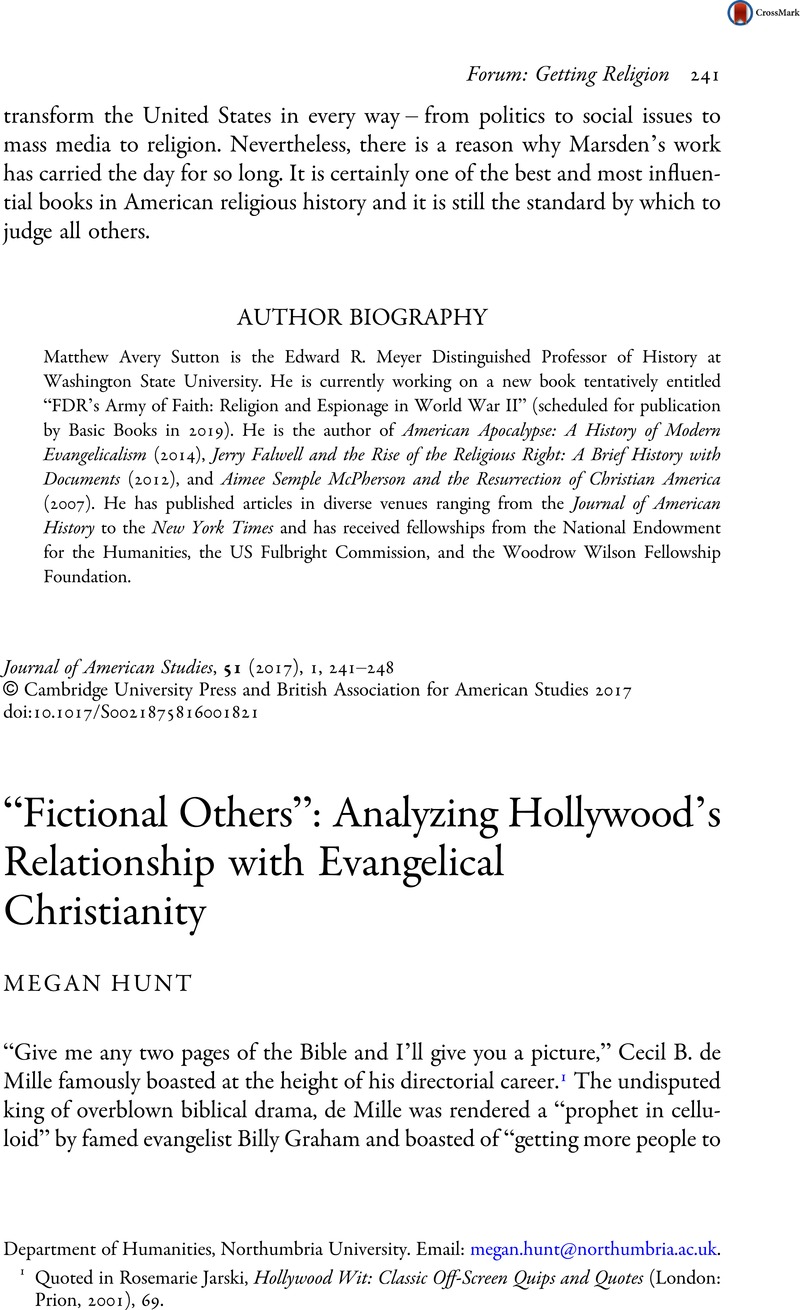Published online by Cambridge University Press: 24 January 2017

1 Quoted in Jarski, Rosemarie, Hollywood Wit: Classic Off-Screen Quips and Quotes (London: Prion, 2001), 69 Google Scholar.
2 Quoted in Katherine Orrison, Written in Stone: Making Cecil B. DeMille's Epic, The Ten Commandments (Lanham, MA: Vestal Press, 1999), 108.
3 Melanie J. Wright, Moses in America: The Cultural Uses of Biblical Narrative (New York: Oxford University Press, 2003), 5.
4 Melani McAlister, Epic Encounters: Culture, Media, and U.S. Interests in the Middle East, 1945–2000 (Berkeley: University of California Press, 2001), 56.
5 Bruce Babington and Peter Evans, Biblical Epics: Sacred Narrative in the Hollywood Cinema (Manchester: University of Manchester Press, 1993), 1.
6 Ibid., 2, 9.
7 Ibid., 9.
8 Tony Shaw, Hollywood's Cold War (Edinburgh: Edinburgh University Press, 2007), 105.
9 From 1950 to 1962, a religious historical epic was the year's highest-grossing film in America. See McAlister, 44.
10 Ibid., 56. See Alan Nadel, “God's Law and the Wide Screen: The Ten Commandments as Cold War ‘Epic’”, Publications of the Modern Language Association, 108, 3 (May 1993), 415–30.
11 See McAlister, 45, 65–66; Adele Reinhartz, Bible and Cinema: An Introduction (New York: Routledge, 2013), 21.
12 William D. Romanowski, Reforming Hollywood: How American Protestants Fought for Freedom at the Movies (New York: Oxford University Press, 2012).
13 Tom Shone, “A Movie Miracle: How Hollywood Found Religion”, The Guardian, 31 July 2014, at www.theguardian.com/film/2014/jul/31/-sp-faith-films-hollywood-religion-christian-noah-heaven-is-real-bible.
14 Ibid.
15 Ibid.
16 Anton Karl Kozlovic, “Sacred Subtexts and Popular Film: A Brief Survey of Four Categories of Hidden Religious Figurations,” Journal of Contemporary Religion, 18, 3, (2003), 317–34.
17 Kozlovic, “The Structural Characteristics of the Cinematic Christ-Figure” Journal of Religion and Popular Culture 8 (Fall 2004), at http://dspace2.flinders.edu.au/xmlui/bitstream/handle/2328/14295/2004054629.pdf?sequence=1 (abstract); Christopher Deacy, “The Pedagogical Challenges of Finding Christ Figures in Film”, in Gregory J. Watkins, ed., Teaching Religion and Film (New York: Oxford University Press), 129–40, 132.
18 Melanie J. Wright, Religion and Film: An Introduction (London: I. B. Tauris, 2007), 60.
19 Deacy, 131.
20 Todd Rendleman. “‘I Know Y'All Think I'm Pretty Square, but tuh, I Believe What I Believe’: Images of Evangelicals in American Film,” Journal of Media and Religion, 7, 4 (2008), 271–91, 271.
21 For examples see Molly Haskell, From Reverence to Rape: The Treatment of Women in the Movies (Chicago: The University of Chicago Press, 1987); Donald Bogle, Toms, Coons, Mulattoes, Mammies, & Bucks: An Interpretive History of Blacks in American Films (New York: Continuum, 1994); Richard Dyer, “Stereotyping,” in Dyer, ed., Gays and Film (New York: Zoetrope, 1984), 27–39; Omer Bartov, The “Jew” in Cinema: From the Golem to Don't Touch My Holocaust (Bloomington: Indiana University Press, 2005); Peter Rollins and John E. O'Connor, eds., Hollywood's Indian: The Portrayal of the Native American in Film (Lexington: University Press of Kentucky, 1998); Jack Shaheen, Reel Bad Arabs: How Hollywood Vilifies a People (Brooklyn: Olive Branch, 2001).
22 Roger Ebert, review of The Apostle, 30 Jan. 1998, at www.rogerebert.com/reviews/the-apostle-1998.
23 Robert Duvall, interviewed by Mark Moring, “The ‘Low’-Down on Robert Duvall,” Christianity Today, 27 July 2010, at www.christianitytoday.com/ct/2010/julyweb-only/lowdownrobert-july-10.html?share=0787alvyfYsKjFKGdPvmKmB5IsLWrlbq.
24 Ibid.
25 Andrew B. Leiter, Southerners on Film: Hollywood Portrayals since the 1970s (Jefferson, NC: McFarland, 2011). Other recent collections, including Larry Langman and David Ebner, Hollywood's Image of the South: A Century of Southern Films (Westport, CT: Greenwood Publishing Group, 2001); and Deborah E. Barker and Kathryn McKee, American Cinema and the Southern Imaginary, Athens, GA: University of Georgia Press, 2011), Introduction, make no reference to religion.
26 Sight & Sound, 25, 5 (May 2015).
27 Gary W. McDonogh and Cindy Hing-Yak Wong, “Religion and Representation in the Filmic South,” in Karl G. Heider, ed., Images of the South: Constructing a Regional Culture on Film and Video (Athens, GA: University of Georgia Press, 1993), 24–54, 27.
28 George M. Marsden, Fundamentalism in American Culture, 2nd edn (New York: Oxford University Press, 2006), 236–37.
29 Wesley Strick, interviewed in “The Making of the 1991 Cape Fear,” DVD special features, Cape Fear boxset, J. Lee Thompson, Martin Scorsese (dir.), Universal Pictures UK, 2001.
30 David Denby, “The Gospel Truth,” New York Magazine, 12 Jan. 1998, at http://nymag.com/nymetro/movies/reviews/1975.
31 Judith Weisenfeld, Hollywood Be Thy Name: African American Religion in American Film, 1929–1949 (Berkeley: University of California Press, 2007), 235–36.
32 Ibid., 236; James Snead, White Screens, Black Images: Hollywood from the Dark Side, ed. Colin McCabe and Cornel West (New York: Routledge, 1994), 3.